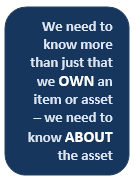I was recently reminded that just because you own something doesn’t mean that you can use it.
The warmer temperatures and hope for Spring got me thinking about getting out and doing something that I haven’t done in years – rollerblading. I’ll admit, as someone who recently hit 50, this could be a questionable decision. But I have the blades and used to skate all the time – so why not?
As you may have suspected, there were some flaws in my plan.
I knew exactly where the skates were in my basement. After all, they had been sitting on that same shelf where I had put them over 15 years ago. The basement is clean and dry, so they should be fine.
I took them upstairs to try them on and noticed that some of the glue from a strap had lost its grip & should be replaced. Not a big deal. Next, one of the plastic sides of the boot started cracking. The material had aged a little but didn’t seem bad. The final blow came when the top strap that keeps everything secure came off in my hands. The skates were unusable, and my plans for that Sunday afternoon were derailed.
What You Don’t Know
We’ve all run into this situation before – maybe not with rollerblades – but with other items. You went to use something that you knew that you had, and it ended up being in no condition to do what you needed it to do. It might have been a suit that you thought would work for an event but no longer fit – or maybe a spare laptop at the office that was way behind on updates. Just because we have something doesn’t mean that it is usable.
The urgency of an inventory activity frequently comes from needing an asset count for financial reporting. Not only does this data help paint a picture of financial health – in some industries, it’s required for regulatory compliance.
But if you rush through the activity and only focus on the count – you could be missing critical information about an asset that could derail plans much bigger than an afternoon of inline skating.
I’m not saying that a count isn’t important – it’s critical to an inventory. But without descriptive information surrounding the count of that asset, you could be setting yourself up for trouble.
Bad or incomplete asset data can have an enormous impact on an organization. Recently, the City of Denver uncovered a mess surrounding its assets when an audit was performed. There were items that were found to be no longer in service. Others were in a location different than what was recorded. One was still on the books despite no longer being owned by the City. These were just a few of the errors that were discovered during a very small audit sampling – but represented the potential for significant discrepancies across their data.
Capture the Condition
Much like other issues, resolutions to problems like Denver’s takes a two-pronged approach: clean up the mess and make sure that it doesn’t happen again. Here are the steps that I recommend:

Understand the Asset
Define what your organization needs to know about each asset. Naturally, it depends on the asset. But at a minimum, you should confirm Count, Location, and Condition:
- Count – confirm that you have it in your possession
- Location – confirm where it is
- Condition – assess if it is in working order
There may be other things that you may need to know that pertain to particular assets (expiration, custodian, etc.). But at a minimum, you should be able to confidently understand what you have, where you have it, and if it’s ready for use.
Prepare a Solution
Arm your team with what they need to capture the asset data that you need. Asset inventory solutions have come a long way from the clipboard approach – and the right ones will pay for themselves within the first inventory cycle. Here are factors to consider when you evaluate options:
- Mobility – does the system work with a mobile scan device that will go where your assets are (regardless of the availability of network or cellular coverage)?
- Asset Attributes – does the system offer an easy way to input condition information beyond just a count?
- Communication – does the system offer an easy way to electronically communicate the inventory data to your ERP or business systems so that additional data entry (and entry errors) can be avoided?
- Intuitive Design – is the system easy to use? Inventories don’t typically happen every day. Users need to be able to periodically pick up the solution and get to work without needing extensive training or review.
Mobile asset inventory solutions can take you a long way to accurate asset data. They can make the inventory job easier by arming staff with a scanner that can confirm the asset and its location – and make it easy for the user to enter information that they discover about the item – like the all-important condition.
Naturally, I’m a little biased when it comes to these solutions since my main role at HL Group is delivering mobilePLUS solutions to our clients. But even I can get comfortable thinking that I have an understanding of what I own when I haven’t really taken a good look at the asset – or rollerblades, as the case may be.
____________________
Anne Hale is the Director of Client Services at HL Group, Inc., a premier provider of mobile inventory management and RFID solutions. She manages our client engagements, helps with sales and marketing, and has a shiny new pair of inline skates (and all of the pads that the sporting goods store sells).




